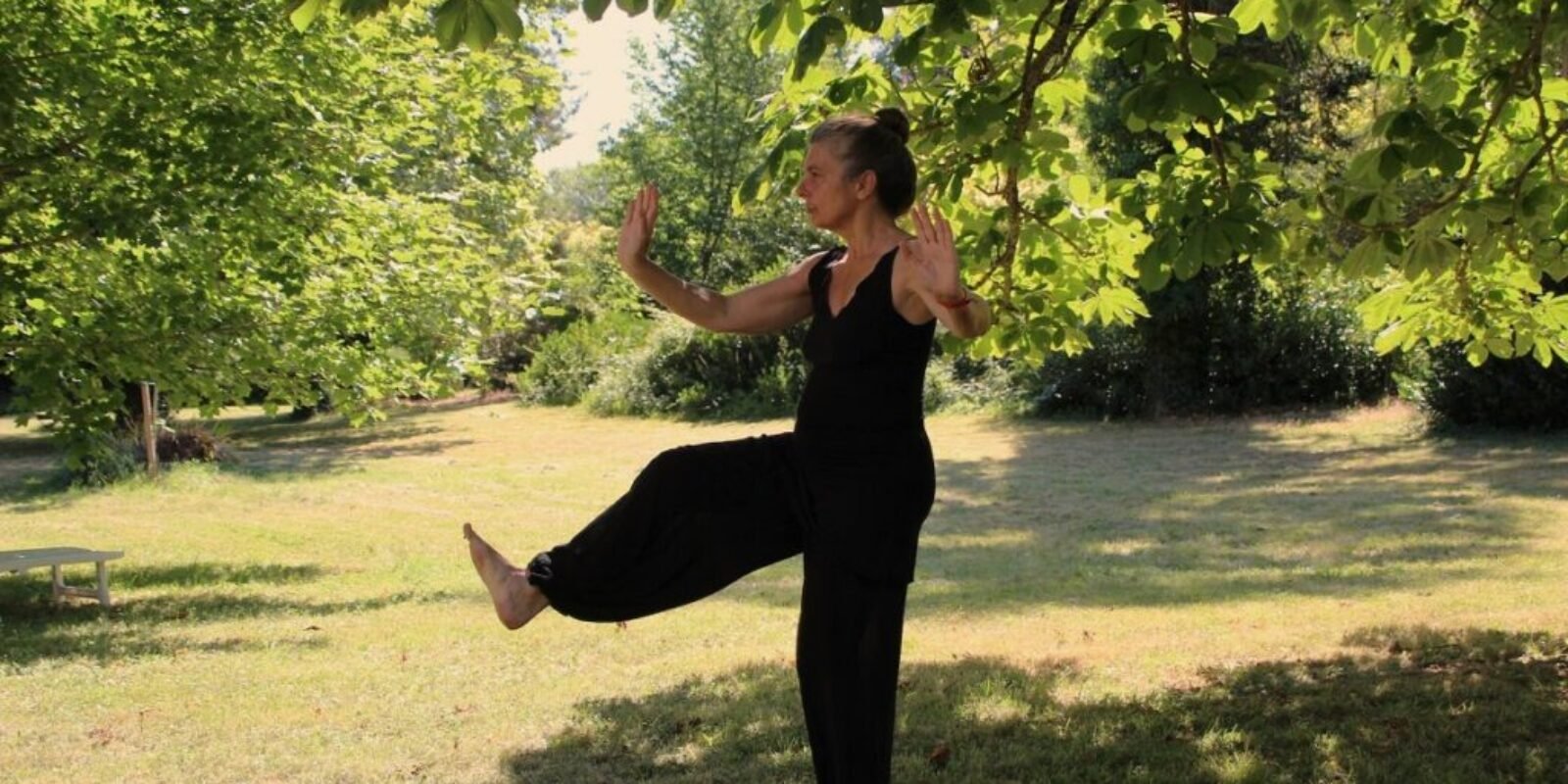Last Updated on July 3, 2025 by Rose Ann Palac
Are you searching for an exercise routine that strengthens your body while calming your mind? Tai Chi might be exactly what you’ve been looking for. This ancient Chinese practice, with roots dating back to the 11th century, has evolved into a perfect fitness solution for seniors and those with mobility concerns.
Unlike high-intensity workouts that can strain joints and muscles, Tai Chi’s flowing, meditative movements create a harmonious balance between physical activity and relaxation. Practiced by an estimated 250 million people worldwide, this gentle art form offers remarkable benefits, specifically valuable during the retirement years.
Why is Tai Chi gaining such popularity among the 55+ community? Research shows its regular practice contributes to improved cardiovascular health, with studies demonstrating reduced blood pressure levels and enhanced heart function.
The deliberate weight-shifting movements strengthen leg muscles and core stability, significantly improving balance — a crucial factor in preventing falls. Additionally, the meditative aspects of Tai Chi reduce stress levels while improving mental clarity and emotional well-being.
In this article, you’ll discover the three fundamental “powers” of Tai Chi for seniors: cardiovascular health enhancement, balance improvement, and mindfulness cultivation. We’ll guide you through several beginner-friendly movements you can try at home, explain the philosophical principles that make Tai Chi so effective, and provide resources for finding classes in your community.
Ready to explore how this ancient practice could transform your physical and mental well-being? Let’s begin your Tai Chi journey together.
Discover the Secret Powers of Tai Chi for Senior Fitness
Senior fitness Tai Chi sounds like something you’d see on the label of a health drink you can only find in specialty stores. But it is not. “Brush Knee and Twist Step.” “Snake Creeps Down.” “Raising the Power.” Those might sound like dance moves, but they’re actually gentle, flowing movements that can transform your health and well-being.
Senior fitness Tai Chi as we know it today combines aspects of ancient Chinese medicine, philosophy, and martial arts. This far-reaching combination makes the core principles of Tai Chi the opposite of those of most modern exercise programs that emphasize fast, vigorous activity.
The practice of Tai Chi is premised on inner strength and personal well-being rather than disabling an opponent. It is also more readily adapted to the needs of seniors and people with injuries.
The movements in Tai Chi are typically calm and graceful, performed in a slow, directed manner. Practitioners shift their weight from one leg to another while coordinating their breathing with each movement.
Prefer to listen rather than read?
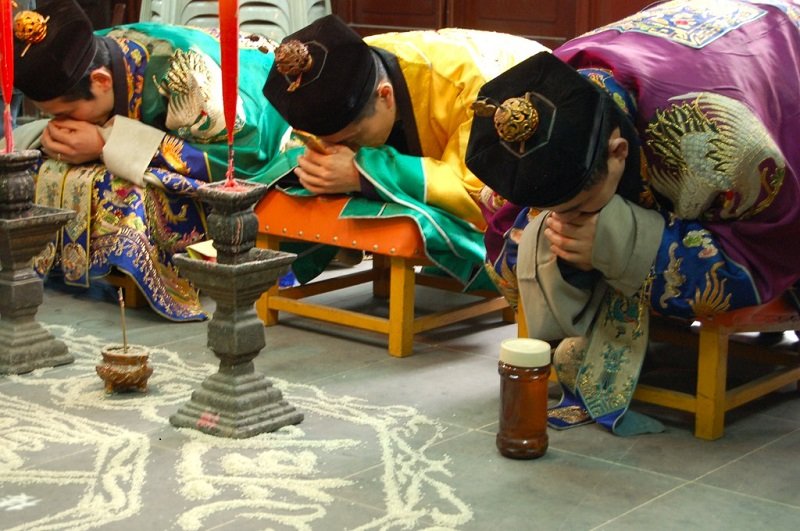
The Benefits of Senior Fitness Tai Chi to Your Well-Being
If you have ever seen a group of seniors performing what looks like dance routines in slow motion in the park in the mornings, then you will have formed a general idea of what senior fitness Tai Chi looks like.
Watching shop owners, businessmen, teachers, clerks, and seniors doing Tai Chi, you probably would not realize that its gentle, choreographed movements make people stronger. But it does. And not just physically stronger, but stronger in the mind, too.
Below are just a few of the benefits you can expect from senior fitness Tai Chi.

Senior Fitness Tai Chi is Good for the Heart
Despite its gentle and slow movements, senior fitness Tai Chi offers substantial cardiovascular health benefits, especially for seniors. While it might not seem as intense as other forms of exercise, senior fitness Tai Chi provides a moderate aerobic workout that can positively improve heart health in several ways.
The rhythmic and flowing movements facilitate blood flow throughout the body. This gentle exercise helps the heart pump blood more efficiently. In turn, improved circulation eases blood pressure in your body.
Regular Tai Chi practice has been associated with lower blood pressure levels. The combination of slow movements, deep breathing, and relaxation techniques can help regulate blood pressure. This reduces the risk of hypertension.
Tai Chi also improves cardiovascular endurance over time. While the movements of Tai Chi are slow, they engage various muscle groups continuously. This gradually strengthens the heart and builds its ability to deliver oxygen-rich blood throughout the body.
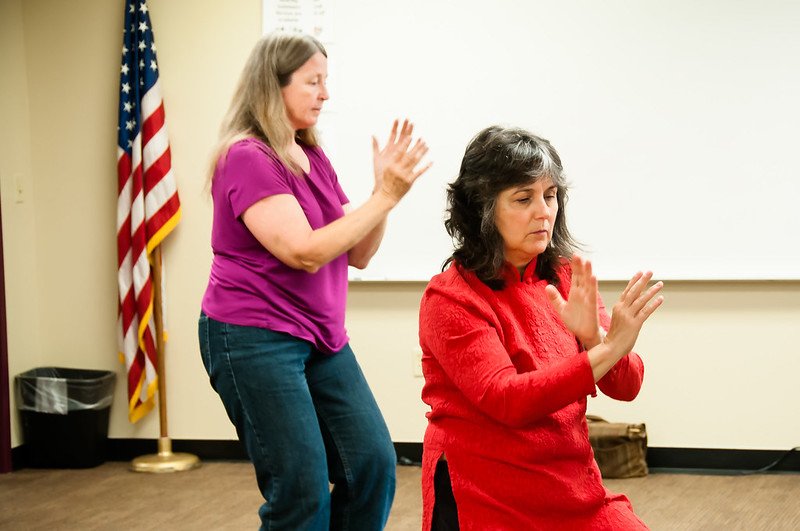
Studies suggest that senior fitness Tai Chi can contribute to a reduction in some risk factors for heart disease. There is also ample evidence to suggest that Tai Chi brings such health benefits as lowering cholesterol levels and decreasing inflammation markers in the body.
Many seniors suffer from stress and anxiety. Senior fitness Tai Chi’s meditative aspect helps ease both. By helping you manage your stress levels, senior fitness Tai Chi supports better cardiovascular health. Some evidence indicates that senior fitness Tai Chi helps in managing irregular heart rhythms or arrhythmias, too.

Senior Fitness Tai Chi Improves Balance and Posture
The slow, deliberate movements in Tai Chi contribute to improved balance and posture. The practice of Tai Chi engages various muscle groups, particularly those responsible for maintaining balance. Over time, consistent practice strengthens these muscles, particularly in the legs and core, which are crucial for stability and upright posture.
The fluid motions and weight shifting in Tai Chi challenge coordination. This practice encourages seniors to develop a heightened sense of body awareness and balance as they learn to shift weight smoothly from one leg to another.
Because Tai Chi movements involve gentle stretches and rotations, it helps improve flexibility in your joints. In turn, improved flexibility enables a wider range of motion, making it easier to adjust body position and maintain stability.
The focus on mindfulness and concentration during Tai Chi cultivates a strong mind-body connection. This awareness allows seniors to adjust their posture consciously, correcting imbalances and maintaining proper alignment.
Tai Chi likewise encourages a lower centre of gravity, which helps stability. By practicing movements that emphasize grounding and steadiness, seniors can better control their body’s position in space, reducing the risk of falling.
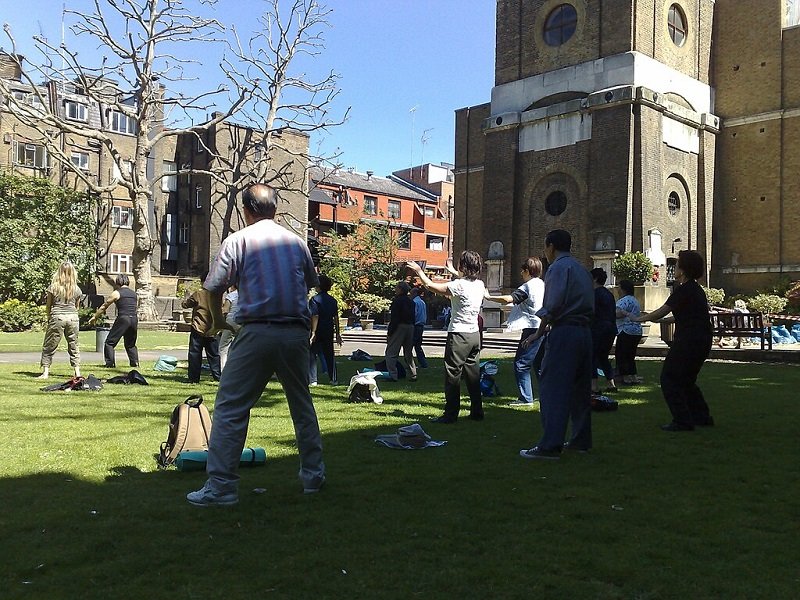
Tai Chi Encourages Mindfulness
Beyond physical exercise, Tai Chi is seen as a means of self-cultivation and personal growth. Practitioners strive to improve themselves through daily practice. Tai Chi is thought to promote greater awareness, patience, resilience, and inner strength. It is rooted in some of the most fundamental principles of Chinese philosophy.
For example, the concept of Yin – a core tenet in Tai Chi – is associated with darkness, softness, yielding, and feminine qualities. Yang represents light, firmness, activity, and masculine qualities.
In Chinese philosophy, the act of striving to balance these two forces promotes one’s mental and emotional well-being. The slow, deliberate movements of Tai Chi are thought to aid the circulation of Qi – or life force – throughout the body, as well. This is said to contribute to mindfulness and vitality.
To practice Tai Chi is to achieve a balance between relaxation and alertness, between strength and flexibility, and between mind and body. In Chinese philosophy, this harmony is seen as essential for overall well-being.
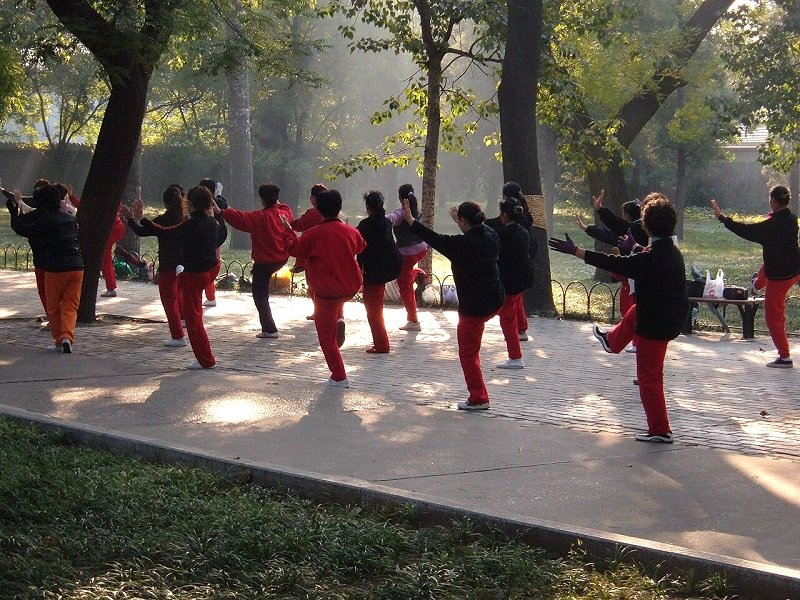
Senior Fitness Tai Chi Exercises You Can Try
Senior fitness Tai Chi offers a graceful and gentle approach to enhancing physical and mental well-being in older adults. Below are three senior fitness Tai Chi movements to get you started.
Parting the Wild Horse’s Mane
“Parting the Wild Horse’s Mane” is a fundamental movement in Tai Chi that involves graceful and flowing motions. You begin this Tai Chi routine in a relaxed and upright stance with your feet shoulder-width apart, knees slightly bent, and arms hanging naturally by your sides.
Maintain a straight posture with your head lifted and your chin slightly tucked in. Slowly shift your weight slightly onto your right leg as you begin the movement. Then, raise your arms in front of you, palms facing downward.
Gradually allow your left hand to move slightly forward up to the level of your chest while your right-hand moves slightly down and back. Your hands should be about shoulder-width apart.
Now shift your weight to your left leg as you begin the motion of ‘parting’ or separating the hands. Rotate your waist to the left, allowing your left hand to move across your body in an arc towards the right side while your right hand follows, moving towards the left side.
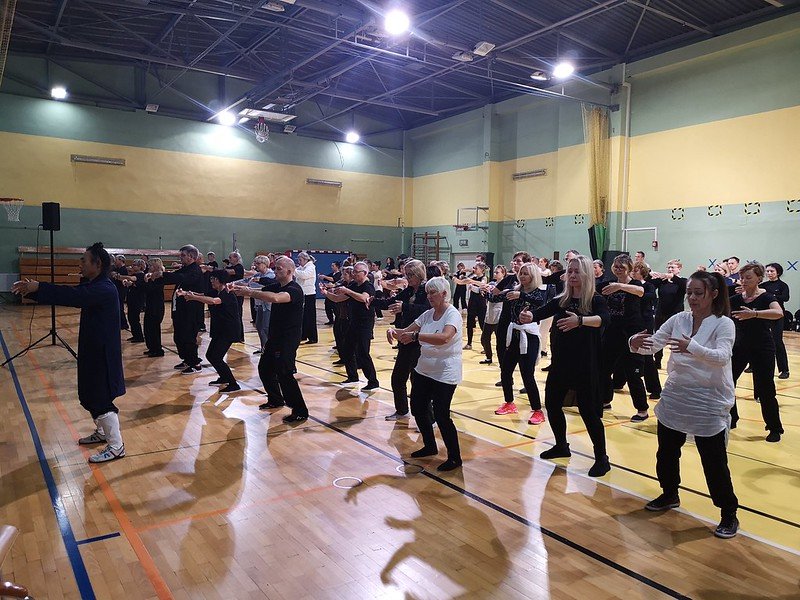
As your hands move, your left palm should face inward and slightly downward. Your right palm should face outward and slightly upward. Your body should turn naturally to accommodate this motion.
Imagine you’re gently guiding a horse’s head to the side as you perform this motion. Keep your movements fluid and continuous. Transfer your weight back to your right leg as your hands complete their arc, ending in a similar position as the starting point but on the opposite side.
Repeat the movement by shifting your weight to the left leg, allowing your arms to ‘part the horse’s mane’ once more in the opposite direction. Remember to coordinate your breath with the movement. Inhale as your arms rise and begin to part, and exhale as your weight shifts and your arms complete the movement.
Focus on maintaining a relaxed, flowing motion throughout the exercise. Pay attention to your body alignment and try to keep your movements smooth and continuous.
Tai Chi Walking
“Tai Chi Walking”, also known as Tai Chi Stepping, is a simple yet profound Tai Chi movement that involves gradual and deliberate steps. The focus is body alignment, balance, and relaxation.
You start this senior fitness Tai Chi movement in a relaxed standing position with your feet shoulder-width apart, knees slightly bent, and your arms hanging naturally by your sides. Maintain a straight but relaxed posture with your head lifted and your chin slightly tucked in.
Slowly shift your weight to your right leg as you lift your left foot. Focus on the movement, keeping it slow, deliberate, and controlled. The emphasis is on mindfulness and balance rather than speed – which makes it a great senior fitness exercise.
Place your left foot forward, heel touching the ground first, followed by the ball of your foot. Ensure a smooth and controlled transfer of weight to the left foot. As your left foot touches the ground, transfer your weight gradually from the right foot to the left foot. Shift your weight forward onto your left foot while keeping the right foot light and relaxed.
Now, slowly lift your right foot, focusing on balance and control. Keep your movements deliberate. Step forward with your right foot, heel first, followed by the ball of your foot. Transfer your weight gradually from the left foot to the right foot as it touches the ground.
Coordinate your breath with your steps. Inhale as you lift your foot and prepare to step forward, and exhale as your foot touches the ground and your weight shifts.
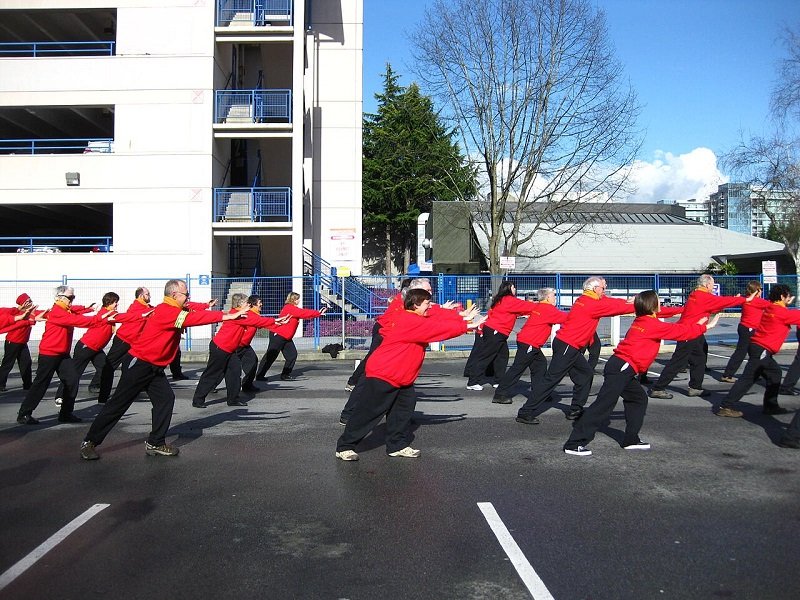
Continue the slow and deliberate stepping motion of this senior fitness Tai Chi routine, alternating between your left and right legs. Remember to maintain a steady and relaxed breathing pattern throughout your repetition of this senior fitness Tai Chi exercise.
Follow the natural rhythm of your body as you continue the Tai Chi Walking exercise. Allow yourself to be fully present in each step, noticing the sensations in your feet, legs, and the rest of your body.
Wave Hands Like Clouds
“Wave Hands Like Clouds” is a classic Tai Chi movement that characterizes the ancient art. Note that this move is done slightly differently in other Tai Chi styles.
Stand with your feet shoulder width apart. Gently bend your knees as you lift your left foot and take a big step to the left. Then, slowly straighten your knees. As you do, lift your arms to chest height, palms facing down and hands and wrists loose and relaxed.
Gently bend your knees back down until you are almost squatting. Keep your arms in front of you all the while.
Then turn at your waist so your stomach and chest face right; as you do, shift your weight onto your right leg and brush your right hand up and across, in front of your face, palm facing inward. Once your hand intersects your midline, lower your arm back down.
Wave your right hand back toward the center. Continue with fluid motion between your waist and arms. Again, when breathing during Tai Chi, use deep, relaxed breaths.
Raising the Power
What makes “Raising the Power” an excellent senior fitness routine is its focus on internal energy – which Taoists call Qi – and promoting a harmonious flow of vitality throughout the body. Begin in a relaxed standing position, feet shoulder-width apart.
Ensure your spine is straight but not tense, shoulders relaxed, and knees slightly bent. Place your hands loosely at your sides. Focus on your breath. Inhale gently through your nose, allowing your abdomen to expand naturally. Exhale slowly, releasing your breath through your mouth.
Continue this deep, relaxed breathing pattern throughout the exercise. Visualize a ball of energy, your Qi, at your lower abdomen. As you breathe in, imagine this energy ball expanding and filling your entire body with vitality and strength.
On the inhale, begin to raise your arms outward and upward in a circular motion, palms facing each other. As your arms rise, visualize gathering more energy from around you and drawing it into your body.
As your arms reach shoulder height or slightly above, pause briefly and concentrate on the energy you’ve collected within your body. Feel the warmth and strength it brings. On the exhale, slowly lower your arms back to the starting position while visualizing the energy settling and circulating within your body, spreading vitality to every part.
Repeat this movement several times, maintaining a calm, focused mind, and a smooth, continuous flow of energy with each breath and movement. After completing the exercise, stand quietly for a moment, feeling the effects of the practice. Finish by gently shaking out your limbs to release any tension and restore normal circulation.

Learning Senior Fitness Tai Chi in Your Golden Years
If you decide to expand your practice of senior fitness Tai Chi, look for community centres, YMCAs, or senior centres that offer Tai Chi classes specifically designed for older adults. These often serve various skill levels and provide a supportive environment for learning.
Explore online platforms that offer Tai Chi tutorials or courses for seniors. Video tutorials and virtual classes allow learning at one’s own pace and convenience, making it accessible from home.
Consider attending Tai Chi workshops or retreats designed for seniors. These immersive experiences provide focused learning under experienced instructors and offer opportunities for concentrated practice.
You may also seek out private instructors who specialize in teaching senior fitness Tai Chi. Personalized sessions are designed for individual needs. This allows you to have a personalized approach to learning and progress.
Combining different approaches based on personal preferences and physical capabilities can make learning senior fitness Tai Chi in retirement an enriching and enjoyable experience, promoting overall health and well-being.
As always, before starting any new exercise regimen, especially for seniors, you should consult healthcare providers or physical therapists to ensure that senior fitness Tai Chi is suitable and safe for you.
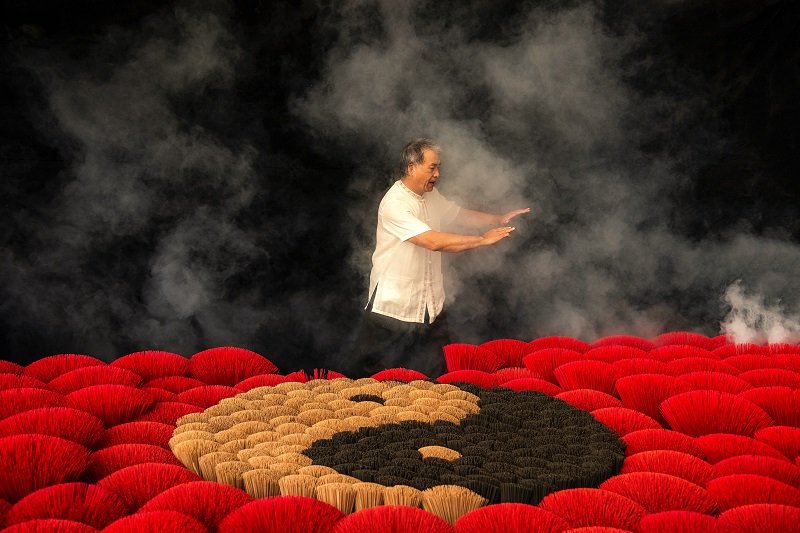
Learn Senior Tai Chi Today!
Senior fitness Tai Chi offers a well-rounded approach to your well-being. Its gentle, smooth movements improve balance, stability, and flexibility, reducing the risk of falls.
Senior fitness Tai Chi improves your overall physical strength. This low-impact exercise promotes joint health, easing stiffness, and enhancing mobility. This makes the practice good for seniors who are managing arthritis or other age-related conditions.
Beyond its physical benefits, Tai Chi fosters mental clarity and relaxation through its meditative nature, reducing stress and promoting a sense of calm and well-being.
The practice of senior fitness Tai Chi is accessible and adaptable, which makes it ideal for older people seeking a gentle yet effective way to maintain their health and vitality.
Are you ready to practice senior fitness Tai Chi today?
Quick Tips for Beginning Tai Chi
- Wear comfortable, loose-fitting clothing and flat, flexible shoes
- Stay hydrated before, during, and after practice
- Begin with shorter sessions (10-15 minutes) and gradually increase duration
- Focus more on relaxation than “getting it right”—tension defeats the purpose
- Remember that slower movements often provide more benefit than faster ones
- Practice in a quiet environment free from distractions when possible
- Consider starting with a seated version if you have balance concerns
Frequently Asked Questions About Tai Chi for Seniors
- Do I need to be in good physical condition to start Tai Chi?
- Not at all! Tai Chi is ideally suited for people of all fitness levels, including those with limited mobility or health conditions. The movements can be modified to accommodate individual needs, and you can practice while seated if standing presents a challenge. Always start slowly and listen to your body.
- How often should I practice Tai Chi to see benefits?
- Recent research suggests that practicing just 2-3 times per week for 30-60 minutes can yield noticeable improvements in balance and cardiovascular health. However, many practitioners find that brief daily sessions of 10-15 minutes provide the most consistent benefits, especially for stress reduction and mental clarity.
- Will Tai Chi interfere with my current medical treatments or medications?
- Tai Chi generally complements conventional medical care rather than interfering with it. A 2023 systematic review published in the Journal of Integrative Medicine found that Tai Chi had positive interactions with various treatments for conditions like hypertension and arthritis. Nevertheless, it’s always wise to consult your healthcare provider before beginning any new exercise program.
- I’m worried about falling during Tai Chi practice. Is this a valid concern?
- This is a common concern, but Tai Chi is actually one of the safest exercises for those worried about falls. Most classes begin with supported movements (near a chair or wall), and instructors trained in working with seniors know how to create a secure environment. Ironically, research shows that regular Tai Chi practice significantly reduces fall risk by improving balance and coordination.
- How long will it take me to learn Tai Chi?
- You’ll likely begin experiencing the relaxation benefits of Tai Chi after your very first session. Basic movements can be learned within a few weeks, though mastering the full forms can take months or years. The beauty of Tai Chi is that the journey itself provides benefits – you don’t need to “perfect” the movements to gain value from the practice.
- Can I learn Tai Chi from videos or apps, or should I find a local class?
- While technology offers convenient ways to learn the basic movements, most seniors benefit greatly from starting with in-person instruction. A qualified instructor can provide personalized guidance, ensure proper alignment to prevent injury, and offer modifications based on your specific needs. Many community centers, senior centers, and YMCAs offer affordable Tai Chi classes specifically designed for older adults.
- Is Tai Chi a religious practice?
- While Tai Chi has philosophical roots in Taoism and traditional Chinese concepts like the balance of yin and yang, the practice itself is not religious. Today’s Tai Chi is primarily taught as a health exercise and moving meditation. People of all faiths (or no faith) can practice Tai Chi without any conflict with their personal beliefs.
REFERENCES
- Lomas-Vega, R., Obrero-Gaitán, E., Molina-Ortega, F. J., & Del-Pino-Casado, R. (2017). Tai Chi for risk of falls. A meta-analysis. Journal of the American Geriatrics Society, 65(9), 2037-2043.
- Sungkarat, S., Boripuntakul, S., Chattipakorn, N., Watcharasaksilp, K., & Lord, S. R. (2017). Effects of Tai Chi on cognition and fall risk in older adults with mild cognitive impairment: A randomized controlled trial. Journal of the American Geriatrics Society, 65(4), 721-727.
- Liu, T., Chan, A. W., Liu, Y. H., & Taylor-Piliae, R. E. (2018). Effects of Tai Chi-based cardiac rehabilitation on aerobic endurance, psychosocial well-being, and cardiovascular risk reduction among patients with coronary heart disease: A systematic review and meta-analysis. European Journal of Cardiovascular Nursing, 17(4), 368-383.
- National Center for Complementary and Integrative Health. (2022). Tai Chi: What You Need To Know. National Institutes of Health.
- Taylor-Piliae, R., & Finley, B. A. (2020). Benefits of Tai Chi exercise among adults with chronic heart failure: A systematic review and meta-analysis. Journal of Cardiovascular Nursing, 35(5), 423-434.
- National Center for Complementary and Integrative Health. (2018). 5 Tips: What You Should Know About Tai Chi for Health. National Institutes of Health.
Disclaimer
The content provided on MySeniors.World is for informational purposes only and is not intended as either financial or medical advice. Always consult a qualified professional before making any investment or health-related decisions.
Posts may contain affiliate links, meaning we earn a commission – at no additional cost to you, if you click through and make a purchase. Your support helps us continue providing valuable content.
